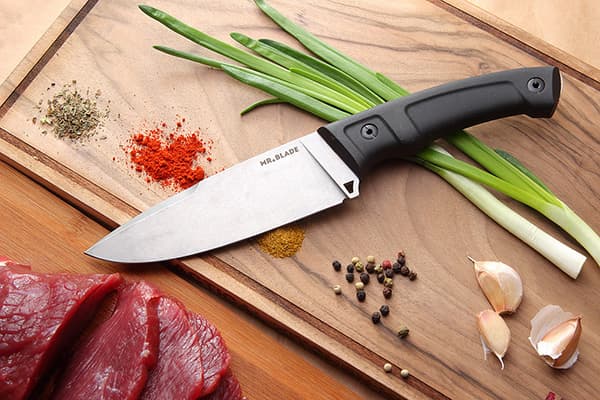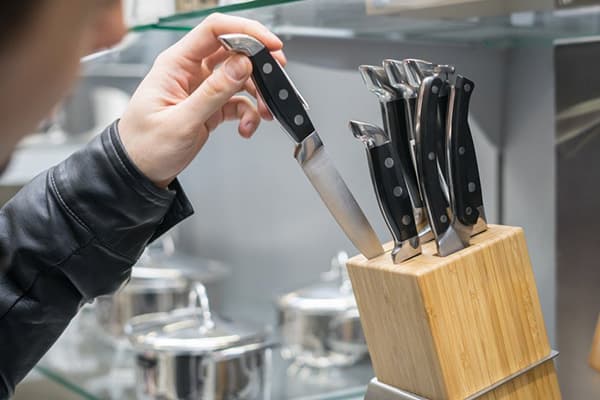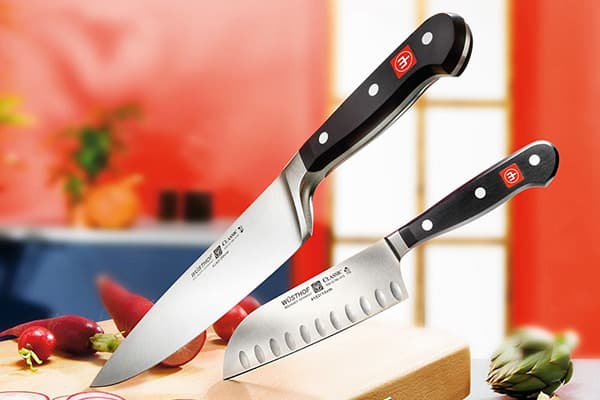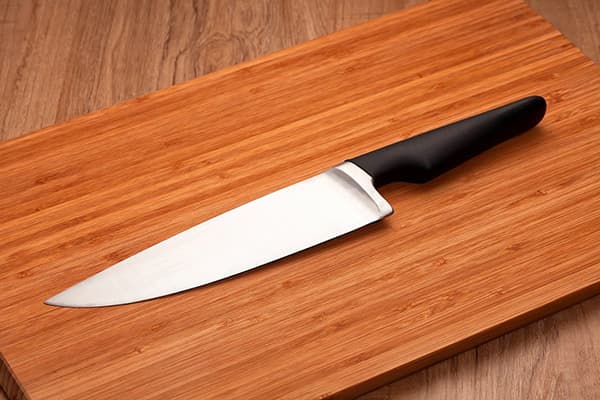How to choose quality knives for the kitchen?
For a modern housewife, a knife is her reliable assistant in the kitchen, capable of saving effort and time and serving faithfully for many years. This means that such a purchase is made for a long time and becomes a “long-term investment.” But how to choose a kitchen knife to meet these requirements?

General points
First you need to decide how many knives will be in a particular kitchen set. And this depends on what dishes are most often prepared in the family. For example, if when cooking large pieces of meat are often cut into bones, hard foods (nuts, avocado, ginger root and the like), then a hatchet knife (cleaver) is definitely needed, and if the housewife buys ready-made fish fillets, then she does not need a filleting knife will be needed.
What are the main types of knives that can be found in the kitchen?
- Universal (with a long blade, about 13 cm). Copes with cutting various products. But for all its versatility, it cannot be the only one on the farm.
- Chef's knife (or just a chef's knife). It has an even longer blade, up to 20 cm. It chops, dices, and chops well. Also allows you to work with different products.
- Vegetable (or paring knife) with a shorter blade (about 8 cm). Designed for cleaning vegetables or fruits, trimming small parts of the product, chopping vegetables and fruits.
- Cleaver. Features a wide blade. Copes with hard foods and thick meats.A small cleaver is convenient for chopping greens.
- Slicing knife. Good for cutting baked meat, boiled pork, meat rolls, etc. into thin, neat slices.
- Bread (with a serrated working edge of the blade). Allows you to carefully cut bread, pies, and other baked goods without crumbling or creasing. Sometimes it is used for cutting vegetables or fruits with thick skin and delicate pulp (kiwi, tomatoes).
- Filling knife. Makes it easier to cut fish - it’s convenient to separate fillets.
In addition, every housewife must have something for sharpening knives: a stone, a machine, or something else. And understand how to properly sharpen a knife with a whetstone or a stone will not be difficult, even for those who have never sharpened knives.
Selecting materials
To choose a high-quality kitchen knife, you must pay attention to the materials from which its blade and handle are made. The ease of use and service life of the knife largely depend on this.
Lever
Usually consists of two parts attached to the metal part of the knife. Can be made of various materials, such as:
- tree;
- plastic;
- bone;
- hardened resin;
- metal, etc.
Keep in mind that soft woods, low-quality plastic or bone are not the best choice for a kitchen knife. They are quite fragile and can simply crumble over a short period of time (sometimes right in the hands, during cooking, injuring the cook). Metal handles are more durable, but add significant weight to the product, which is not convenient for every housewife.
An important point when choosing a handle material is that it should have a non-slip surface, but at the same time be easy to clean.
Blade
Usually housewives have a vague idea of the materials that are used to make it. Many people think that the cutting part should be metal or stainless.
In reality, everything is somewhat more complicated. Stainless steel can have different carbon contents. At the same time, high-carbon steel is better than ordinary stainless steel, provided that the carbon content is adequate for the purpose. Because if this value is too high, the blade will become more fragile and prone to rust (although it will remain sharp for a long time). Too low a carbon content makes the metal flexible and dull quickly (and sharpening stainless steel is not so easy).
In addition, you should pay attention to the method of steel production. Forged is stronger and more durable than stamped, but costs much more.
Try to store such products in a dry condition in a ventilated area. Otherwise, even “stainless steel” will quickly become covered with rust.
But there is another promising material from which blades are made - ceramics. It holds an edge for a long time, while a ceramic blade can be sharpened to the point of a surgical scalpel, and it will not rust due to the absence of metal in its composition. True, ceramics are a very fragile thing, it crumbles easily and even breaks, this especially applies to cheap products.
Let's look at it in detail
It is clear that the quality of materials is the main, but far from the only requirement in order to choose good knives for the kitchen. What else is important?
- The metal part of the knife must be solid - from the blade to the handle. Any joints at the beginning of the handle make the knife less durable.Also fragile are models in which the metal part of the handle is much shorter than its shell, that is, it does not extend to the end of the coating, but is inserted into it. If the handle is completely “filled” with coating, the length of the knife in it cannot be determined at all.
- The blade should not have external defects: scratches, pits, cracks, rust, welds, nicks. Sharpening takes place along the entire length of the blade: from tip to tip.
- The rear edge of the cutting part should end with a special protrusion (stop) that prevents the hand from slipping towards the blade.
- The handle should not have cracks, gaps, or roughness, which reduce the service life of the knife, make it unhygienic and complicate maintenance. Covering this area too thin is also not a sign of a quality product.
- Balance, that is, the balance of the weight of the blade and the handle, on which the force applied when working with a knife depends. In other words, when you need to cut a large volume of food, an unbalanced knife puts much more stress on your hand, and it gets tired quickly. A properly balanced knife will maintain its balance when placed on your finger at the point where the blade meets the handle. Attention! This test requires great care, since cheap models are usually unbalanced and will inevitably fall.
Beware of purchasing knives with serrated edges, which are marketed by sellers as requiring no sharpening, universal use for all products, and sold at a “bargain price.” This is a publicity stunt. The toothed model has a very limited area of application, as mentioned above; it becomes dull quite quickly, and it is impossible to sharpen it. So in this case it is not worth the money.
Subjective factors
It should be taken into account that kitchen knives are personal items. That is, in terms of their ergonomics, they must correspond to the sensations of a particular housewife (or owner). There are two main indicators here: the comfort of the handle and the correct weight. Based on this, it is important to “test” several different knives for the same purpose in order to choose the one that is most convenient to use.
It should also be taken into account here that knives for soft and delicate products are always lighter than for dense ones. But the weight of both should be comfortable.
Another subjective factor is diversity. That is, you need to buy only those knives that are needed in a specific kitchen. Therefore, it is not always advisable to purchase a ready-made set of knives, although in general such a purchase will be cheaper. If the composition of such a set meets specific requirements, you still need to hold each item in your hand separately before purchasing the set. It is for this reason that it is very inconvenient to purchase knives through online stores (unless the owner has already used exactly the same model purchased in a real store of this company).
And one last thing. For many consumers, quality knives are associated exclusively with expensive brands. However, in practice this rule is not always true. We often overpay a lot just for the brand, despite the fact that products of the required quality can be purchased from less fashionable and “promoted” manufacturers.
To make knives last longer, use them only for their intended purpose. Do not use them to cut ropes, bags, or foods that they are not intended to cut. This makes them dull much faster (as does washing them in the dishwasher!).Namely, dull knives are the most common cause of injuries during cooking, since more force has to be applied to cut, which is why the blade often slips and cuts into the hand with all the applied force.
By the way, the second reason for getting cut wounds during cooking is the use of someone else’s knife that doesn’t feel familiar to you. Therefore, a guest’s offer to help the hostess with cutting can be very reckless for him.
Choosing a high-quality knife that meets all the requirements is not so simple: it must be free of defects, made of good, durable materials, easy to use, not overload your hand, easy to wash, sharpen, not rust, and preferably have a reasonable price . But if the purchase is made correctly, the expenditure on it will be repaid by comfortable operation and a long service life.



